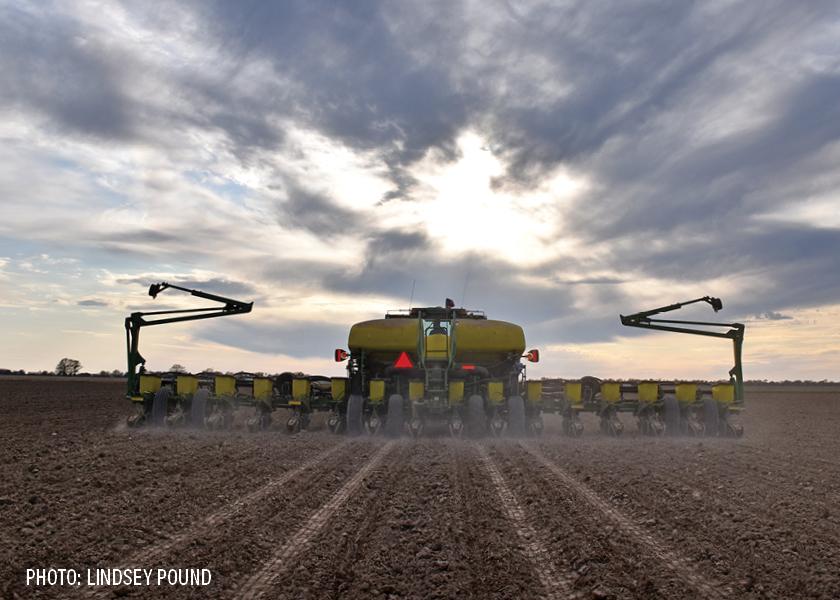9 Steps to a Perfect Corn Stand

More ears at harvest is the key to higher yield. That requires starting with a picket-fence stand with photocopied plants, achieved by adjusting your planter as conditions change from field to field and within fields, says Farm Journal Field Agronomist Ken Ferrie.
1. Plant into the best possible seedbed.
“You must be ready to plant when soil conditions are right,” Ferrie says. “But just because one field is ready doesn’t mean others are. Your pest boss and team must have the skills to know which fields are ready and help your planting crew plan their attack.”
In terms of creating the perfect seedbed, Ferrie says, make adjustments based on your system:
- Conventional horizontal tillage: Manage clods and don’t let soil dry out.
- No-till: Spread residue uniformly behind the combine, manage field traffic and apply a burndown herbicide in the fall for winter annual weeds.
- Strip-till: Build a good strip in the fall.
2. Leveling your planter is no longer a once-per-season job.
A level planter is critical to the closing wheels, row cleaners or coulters, down pressure and seed placement, Ferrie explains. “If you use both conventional tillage and no-till, relevel each time you switch systems because the tractor wheels will sink in a conventional seedbed but not in no-till,” he says.
3. Check and recheck seed depth.
“The key to photocopied plants is placing all seeds at the same depth, in uniform temperature and moisture,” Ferrie says. “You must ground-truth seed placement. Dig seeds in several rows and in different soil types.”
4. Check down pressure on depth wheels.
Stop the planter in the ground, grab a depth wheel and see if you can turn it, Ferrie says. “If it turns easily, you’re not running enough down pressure; if you can’t budge it, you probably are running too much.”
With conventional horizontal tillage, you might need to only check a few rows because the seedbed is uniform, he says. In no-till, strip-till and vertical tillage, check every row.
“If you can control down pressure from the cab, increase it until you reach 95% ground contact, but then get out and ground-truth performance,” Ferrie says.
5. Avoid sidewall smearing.
“Sidewall smearing causes problems with seed/soil contact and root development,” Ferrie says. “It most often occurs in no-till, but it also occurs in conventional tillage if the soil is too wet for the amount of down pressure being used.”
Slicing across the furrow, you should see no seams or signs of how the seed was placed in the trench. “If cross-sectioning reveals a seam, reduce down pressure and see if it disappears,” Ferrie says.
If you can’t eliminate sidewall smearing without giving up consistent depth, you must make adjustments. “With technology, you can adjust down pressure by the row and by the foot, automatically, as you cross different soil conditions,” Ferrie says. “If you don’t have the technology, adjustments will be for the whole planter and the entire field, so make your settings in the toughest area.”
Be especially alert for sidewall smearing if you run a high-speed planter. “The faster you go, the more row units want to come out of the ground, increasing the need for more down pressure.” Ferrie says. “If slowing down helps, you may only need to do it in the areas giving you trouble. But if reducing down pressure and slowing down doesn’t help, the field is too wet to plant.”
Adjustments to your closing system, such as spader wheels, closing disks and wedges that toe out the closing wheels, can break up sidewall smearing after the seed is placed.
“When trying to destroy smeared sidewalls after seed is placed, be careful to not move the seed,” Ferrie says. “Be sure the furrow is firm so the soil does not dry out.”
6. Help wet fields dry out.
In conventional tillage, give the field more time to dry, Ferrie says. In no-till, wait or run a vertical harrow or a row dryer to dry the strip for planting. In strip-till, run row fresheners a few days before planting.
“If only 20% of the field is too wet, fix only that area,” he says.
7. Adjust row-unit coulters by field.
“Coulters help in no-till, but they pin trash in the furrow in tilled fields,” Ferrie says. “Take them off in conventional, vertical till or strip-till conditions.”
8. Adjust row cleaners for each field.
Row cleaners set too aggressively will move dry soil from the surface, putting the depth wheels and disk openers into wet soil underneath, Ferrie explains.
“Set correctly, they can do tillage ahead of the openers, and move clods and residue, while leaving dry soil in place for the planter to run on,” he says.
9. Use technology to manage variability.
Modern planters can be adjusted row by row and even foot by foot, on the go, to fit any soil or tillage system. “The more variability you have in planting conditions, the more technology will pay,” Ferrie says.
The ideal planting window seems to be getting shorter, Ferrie notes. “The more technology and operator skill, the more you can push conditions and still get a good stand,” he says.







